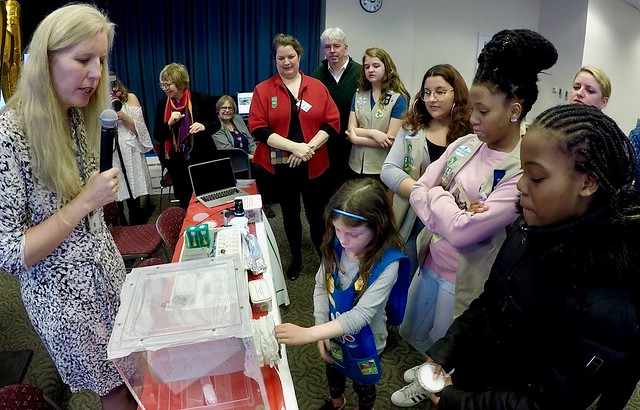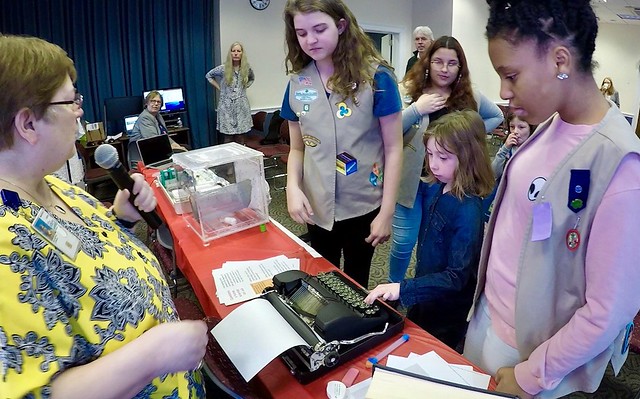
“It felt a little buzzy,” said Lily Meritt, 7, a Daisy Girl Scout from Montgomery County, Maryland. She watched hungry mosquitoes through a plexiglass container as a USDA research scientist talked about pests that love to bug people. Lily and other D.C.-area Girl Scouts visited USDA headquarters to meet women scientists, learn about their work, and discover career possibilities in science, technology, engineering, and math (STEM).
The event honored the Girl Scouts birthday, and was hosted by the USDA Women in Ag (WIA) Employee Group, which is dedicated to mentoring and fostering professional development for women across USDA.
Panelists spoke about their professions and offered advice to the girls. Among them, Dr. Chavonda Jacobs-Young, Acting Under Secretary for Research, Education, and Economics (REE) and current Administrator of the Agricultural Research Service (ARS). She was joined by other speakers from ARS, Animal and Plant Health Inspection Service (APHIS), U.S. Forest Service, Food Safety and Inspection Service (FSIS), Natural Resources Conservation Service (NRCS), and the Office of the Chief Information Officer (OCIO).
Getting girls curious about science is essential to the future of the agriculture sector. According to the U.S. Department of Commerce, women filled 47 percent of all U.S. jobs in 2015 but held only 24 percent of STEM jobs. At the same time, there is a shortfall of graduates with expertise in food, agriculture, natural resources, and the environment, according to a recent Purdue University study.
During another demonstration activity, the girls gathered around a manual typewriter from the 1950s. “You have to hit the keys hard,” said Susan McCarthy of the National Agricultural Library, as she talked to the scouts about the changing technologies of communications. Savannah Welch, 14, of Girl Scout Troop 2713 in Bowie, Maryland, tried her hand at typing a sentence. “They make things a lot easier for us nowadays,” she observed.
Welch remarked that the event gave her ideas for her future. “I learned a lot today, about the possibilities that I could have. I see that so many females that started off kind of where I am could grow up to be successful women. I feel like it put a lot of extra options on the table for me,” Welch added.
“It’s their future,” said Lisa Grover, Girl Scout Troop 6 co-leader in Anne Arundel County, Md. “They will be ahead of the curve if they have this early exposure.”
With 1.8 million Girl Scouts nationwide, the organization is committed to increasing girls’ interest in STEM, educating girls about STEM careers, and exposing girls to STEM professionals. In 2017, the Girl Scouts introduced a substantial rollout of 23 new STEM-related badges. Girl Scouts can create algorithms, design robots and racecars, go on environmentally conscious camping trips, collect data in the great outdoors, try engineering, and much more.
The USDA is equally committed to showing girls future STEM career opportunities. The USDA Office of Partnerships and Public Engagement (OPPE) welcomes Girl Scouts across the Washington region to learn more about women who have science careers at USDA. For more information, Girl Scout leaders and other educators may contact OPPE at agwomenlead@usda.gov.

